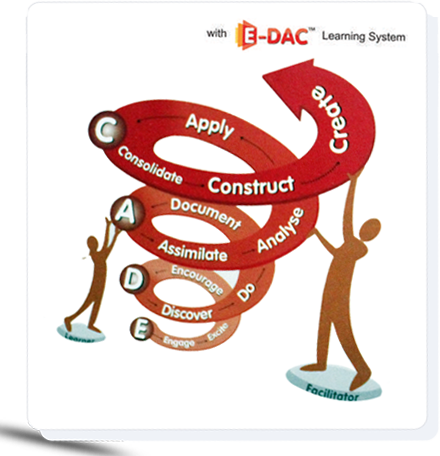 What is the E-DACTM approach to learning?
What is the E-DACTM approach to learning?E-DAC is an acronym in which each letter signifies the four-fold sequence and methodology that is applied in the classroom.
The learner here learns through a joyous discovery of the self and the world around, leading to positive outcomes.
E-DACTM stands for:
> E – Engage and excite the learner to learn through environment
> D – Discover and learn by doing, and document to retain knowledge
> A – Analyse, assimilate and apply knowledge and skill
> C – Consolidate, construct and create to build and add to exciting learning and skill for life
E-DACTM approach to learning is an innovative yet scientifically designed methodology and its adoption in the classroom through each stage of learning is briefly elucidated below.
E – “Engage and excite through environment”
E-DACTM is based on the belief that learning happens when attitude and perceptions are positive. E-DACTM curriculum uses the environment-both within and outside the classroom-as a medium of teaching-learning. Therefore, the environment is made conductive through the The Walls Speak concept and through various activities that engage the learner and develop a positive attitude towards the learning to be acquired. Since all learners are unique, the varied activities are planned to cater to their individual needs and learning styles. This ensures that the learners are ready to begin their journey through discovery on a positive note.
D – “Discover, do and document”
The learner internalizes knowledge through experience. Facilitators are equipped with the E-DACTM teaching strategies that help the learner have a pure, guided or expository opportunity to discover and learn. TM provides creatively designed textbooks along with skill building games and projects for the learner to encourage the spirit of discovery and enquiry. With every discovery the learner pauses to internalize and then documents his/her learning in his/her unique style.
A – “Analyse and apply”
Analyse and apply Learning does not stop with merely acquiring knowledge. The most effective learning occurs when a learner is able to use acquired knowledge meaningfully. Learners are assigned with the context-specific tasks where they apply their newly acquired knowledge. This stage requires higher order thinking skills by which the learner can put the knowledge gained to practical use. E-DACTM introduces the learner to problem solving and builds life skills through these exciting real life situations.
C – “Consolidate, construct and create”
E-DACTM ensures that the mind acquires knowledge for life through its various sequential stages but holistic learning can happen only when the learner has learnt to add to exciting knowledge. E-DACTM helps the learner create and exhibit something new in the form he/she is comfortable with.
E-DACTM is a creative process that leaves the learner with an inherent sense of joy and confidence and enables him/her to discover him/her true potential.
 Smartclasss E-DACTM
Smartclasss E-DACTM
Along with the E-DAC TM learning approach the Takshila School uses technology as a learning tool and adopts the well known learning tool SmartclassTM in the classroom. The digital content library is well equipped with pedagogically sound and highly animated lesson-specific 2D and 3D modules that allow facilitators to effectively deliver lessons in a classroom. Audio books based on language concepts are also used to enhance the listening skills of students.
Learners’ performance is evaluated using the Smart Assessment System TM.
Learning Centres TM
Labs – Well equipped Science and Computer Labs
Library – Well equipped with books for all age groups
Sports Facilities – Playground and sports equipment
Infirmary – First aid kit and periodic check-ups by medical specialists
Parent Connect
At Takshila School we believe that parents are our partners in the progress of their child. Hence, regular interaction between parents and teachers is encouraged to establish a stronger and better learning environment for children, both at school and at home.
Talent Development
Each child has inherent talent. The Takshila School nurtures this talent carefully. Interest Clubs (10 Clubs) are an integral part of the curriculum and help every student to discover and develop his/her skills.
Formative Assessment System
The E-DAC TM Assessment system is a comprehensive, articulate and continuous assessment system that is embedded in the daily teaching-learning process. It is a appreciative and motivating but not critical or judgmental. It helps the learner to understand his/her aptitude and then guiders him/her to vocations/careers based on their interest, aptitude and scores.
Flipped Classrooms
This is a pedagogical practice in which things which are traditionally done in schools are done at home and vice-versa. At BMPS Takshila school both classwork and homework are done in school thereby ensuring that the parent and the child spend quality time at home with each other. Special homework periods are assigned to each class following the EDAC curriculum. Teachers and students help each other to complete the given home assignments.
Curriculum for Classes 8th, 9th, 10th & 12th is according to the CBSE (Central Board of Secondary Education).